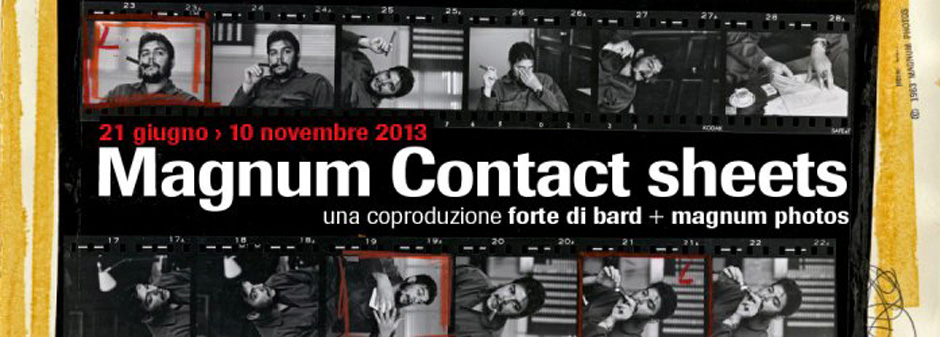
L’uscita del volume Magnum Contact Sheets, nel 2011, venne accompagnata - giustamente - da frasi come “cosa c’è dietro le icone della fotografia”, “come i fotografi hanno fatto le loro scelte”, oppure in un’ottica quasi da backstage, “il lavoro del genio”. Così è stato per la mostra itinerante che ne è scaturita, e che ha ripreso il concept e le intenzioni del volume. Tutte definizioni corrette, puntuali, efficaci, per cercare di raccontare un’agenzia, immagini, e fotografi che hanno fatto la storia degli ultimi 70 anni.
La cosa su cui siamo tornati a riflettere, al tempo della fotografia ubiquitaria e immateriale, è che queste immagini ci raccontano storie che abbiamo già sentito - appartengono ormai al nostro immaginario - ma in un altro modo: assistiamo qui alla ricostruzione, seppur parziale, di parti del mondo, un mondo passato, che le icone avevano lasciato fuori campo.
Le immagini di Rene Burri, che fanno da locandina alla mostra, sono esplicite in tal senso: Ernesto “Che” Guevara, l’icona di un epoca e di un’idea, qui si stropiccia gli occhi, appare forse un po’ rilassato, come fosse al bar, mentre Lara Bergquist di Look - per noi interlocutrice invisibile - lo intervista: avvertiamo l’intromissione del quotidiano nel santino del “Che”.
Ancora, guardando i ragazzini che giocano tra le macerie di una Siviglia devastata di Henri Cartier-Bresson - quasi una premonizione di quello che sarebbe stato anni dopo - così scanzonati, poco o nulla interessati al fotografo, li vediamo ignari della portata che quelle immagini avebbero avuto sul nostro immaginario.
Questi contact sheets hanno anche il merito di ridurre leggermente la mitologia del fotografo come camera-hero, riportandolo a livelli più terreni, quasi colloquiali.
Spesso, solo dopo la review si crea l’icona: Erwitt si accorse poi visionando i provini di aver catturato quel bacio incorniciato nello specchietto retrovisore, che divenne uno dei suoi scatti più celebri.
Nei casi in cui invece la contingenza è soverchiante, come nelle immagini del D-day di Capa - potentissime - oppure del Maggio parigino di Barbey, o la presa dell’ambasciata americana a Teheran di Abbas, alcuni dettagli presenti negli scatti “esclusi” improvvisamente emergono, come tasselli mancanti: i cavalli di frisia nell’acqua gelida; la sigaretta di un dimostrante in boulevard Saint-Germain; le scale a pioli usate dai khomeinisti in rivolta...
Martine Franck, anche lei parte di Magnum e compagna di Cartier-Bresson, ammise di sentirsi quasi violata nel pubblicare i provini e, sapendo di mostrare qualcosa di molto intimo, correva il rischio di «rompere l’incantesimo, di distruggere un certo mistero».
Nonostante questa paura, l’incantesimo sembra qui rinnovato, e le icone sembrano avere adesso più tempo e più spazio intorno, guadagnando un’aura tutta terrena. Sappiamo che il Che ha bevuto il caffè quel pomeriggio, che i cingolati dei sovietici riempivano di polvere le strade di Praga, e che l’imbianchino della Tour Eiffel ha guardato in camera - almeno una volta. Nessun mistero, quindi, se quelle immagini adesso ci sembrano più vicine che mai.
Gabriele Magazzù
ENGLISH VERSION
When the volume Magnum Contact Sheets, was first released in 2011 it was often associated with such statements as “What’s there behind the icons of photography?” or “How photographers made their choices”. At times it would even be linked to a kind of “backstage” viewpoint, in such terms as “the work of a genius”. That’s how the itinerant exhibition that came of it turned out to be - by reflecting the concept and intentions of the book. All these definitions are correct and incisive to the extent they try to describe the agency, images and photographers that have been making history for the past 70 years.
Going back to ubiquitous and immaterial photography, we pondered upon the fact that these images do tell stories we’ve heard of before - for they’re part of our collective imaginarium. However, they do so in a different way: here we witness the (partial) reconstruction of bits of a past world - a world that had been put aside by icons.
Rene Burri's, images are used as poster for the exhibition and they’re quite explicit in that sense. Here, the icon of an era, Ernesto “Che” Guevara, rubs his eyes and appears somewhat relaxed - as if he was at a bar. Our invisible speaker Lara Bergquist from Look interviews him, and we perceive the meddling in his everyday life - as though we were peeping at that of a holy picture.
As we look at Henri Cartier-Bresson’s boys playing amongst the ruins of torn Siville it almost feels like a premonition on what would occur years later. They appear so easy-going as if they were paying no attention to the photographer whatsoever - utterly unaware of the impact those images would have on our outlook.
One of these contact sheets’ merit is that of downsizing the mythology around photographers as camera-heros. They take it back to more earthly, almost informal levels.
The icon is often created only after its review. Take one of Erwitt's most famous photos - the kiss framed in the rearview mirror. He noticed it only as he was going through the proofs.
On the other hand, there are cases where contingency is overwhelming - see Capa’s powerful D-day images, Barbey’s Parisian May or the takeover of the American embassy in Teheran by Abbas. Details of the “excluded” shoots suddenly re-emerge like missing tiles: the Frison horses in frozen water, the cigarette of a protester in Boulevard Saint-Germain, the rung staircases used during the Khomeini uprising…
Magnum’s member and Cartier-Bresson’s wife Martine Franck admitted she almost felt violating when publishing proofs. Realizing that she was about to show something extremely intimate, she risked “breaking the spell and a destroying a mystery”.
Despite this fear, here the spell is renewed and icons now seem to have more time and room on their hands whilst gaining a completely earthy aura. We know that Che drank coffee that afternoon, Soviet caterpillars were filling the streets of Prague with dust and that the Tour Eiffel’s painter looked to the camera at least once. No wonder that those images now feel closer than ever.

Leave a Reply